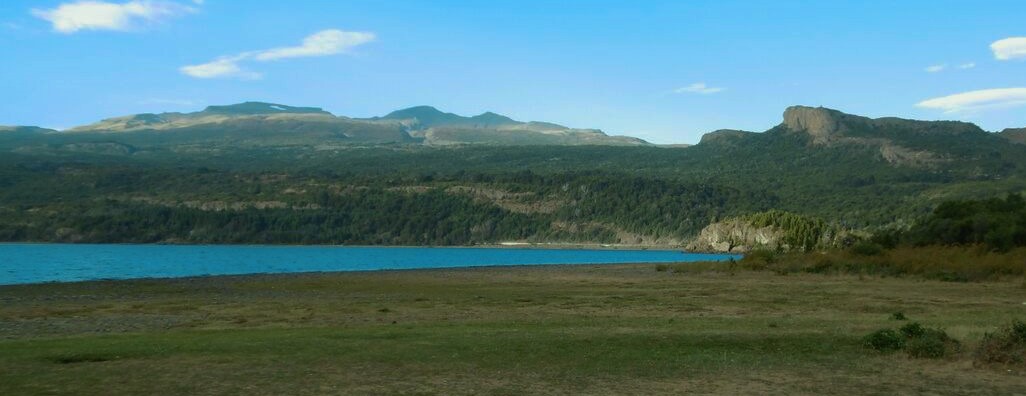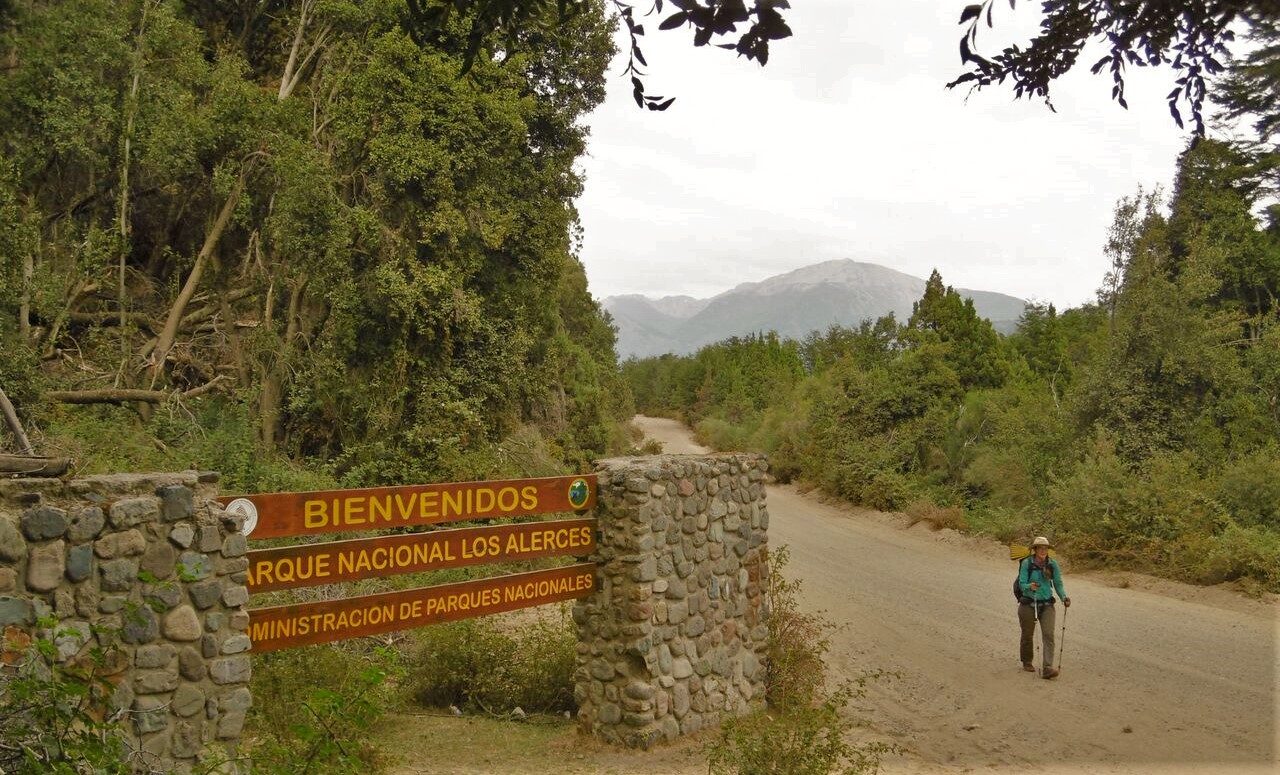Haz clic aquí para leer en español
 The Patagonian Alerces (Fitzroya), a conifer, is the largest tree species in South America. Their trunks are bigger around than two of us could reach. In the early years of settling Patagonia they were used for construction or tracts were burnt to make space for farming. As they became more scarce their wood was used as a currency, and by 1976 it became illegal to log them.
The Patagonian Alerces (Fitzroya), a conifer, is the largest tree species in South America. Their trunks are bigger around than two of us could reach. In the early years of settling Patagonia they were used for construction or tracts were burnt to make space for farming. As they became more scarce their wood was used as a currency, and by 1976 it became illegal to log them.
An interesting consternation in Patagonia is that, while it is illegal to log the trees, if already burnt, they and the area cleared by the fire many be used for industry. 97% of forest fires in Patagonia are man-made.
The small, seasonal villa of Futalaufquen is the southern gateway into the popular Los Alerces National Park. It was the last holiday weekend of the summer, and the park would be closing in a few days, so there were many people about, peeping curiously over the fences of their summer homes at the band of dirty females dragging in.
Of the two small shops, one was open through siesta. Neon was ill and slept on a patch of grass as I went about the town chores. Stocking up our food rations, securing maps of the Huella Andina, and sorting what to do with not our dog, NoMio. Because we were entering a national park, we had to part ways.
A guardaparque explained that it is a common occurrence for dogs to adopt travelers for periods of time. She hopped readily into the bed of his truck but her yips and the look of betrayal on her face when I did not leave with them bother me still. She was a wonderful little companion.

The park is a drive-through for most visitors. Our route was part trails, part road-walk. We alternated between following along the rocky shores of the lakes and rivers, which flow into the Futaleufú, and the dusty roads above. As we road walked, we debated the effects of drive-by tourism, weighing the reasons for and the pros and cons of it.
Having become accustomed to moving and living freely, it was an adjustment to stay in sites at designated camping areas. There were three levels of accommodations in the park: the free park campgrounds, the pay private campgrounds, and the guest houses.

While at the free sites there were bathroom buildings, they were all very much locked and had been for some time. The sinks had been removed and the entire area was ringed with toilet paper flowers.
I was disgusted.
And livid.
While the responsibility comes down to each of us and how we deal with a situation (bury your paper or pack it out), it did seem ridiculous to have established campgrounds of 30 campsites and no facilities.
Speaking with one of the head guardaparques, I asked about it. “Those campgrounds are free,” he answered, as if it was the most logical thing in the world, “if you want amenities, you go to the pay sites.”
I spent the next several kilometers mulling over the difference between “amenities” and “basic sanitation.”

Variety being the spice of life, it was nice to alternate between road and trail. At one point we had missed a juncture where we had hoped to hop back on the Huella. As we walked along, a car going uphill slowed and stopped. The driver was one of the guides from Canal Fun who had helped us get started back on Tierra del Fuego.
He and his girlfriend were on a road-trip and really excited to find us still walking. He gave us a drink of water and a muy buena onda (good vibe) which helped us through the rest of the park. It was another of those chance encounters which assures us we are at just the right place at the exact right time.
In the end, on our way out, we spent a night at one of the pay facilities and let Neon recuperate. It was nice to take a rest day out on the trail. Towns are stressful with so much to take care of and the pressure to write. Out there, we napped, ate, read, and chatted with friends and family back home.

Parque Nacional los Alerces
Traducción por Henry Tovar
 Los alerces Patagónicos (Fizroya), un conífero, es la especie de árbol más grande de Suramérica. Sus troncos alrededor son más grandes de lo que las dos de nosotras podemos alcanzar. En los primeros años de los asentamientos de la Patagonia fueron usados para la construcción o fueron quemados para hacer espacio para la agricultura. A medida que se hizo mas escaso se utilizo la madera como una moneda, y en 1976 se convirtió en ilegal talarlos.
Los alerces Patagónicos (Fizroya), un conífero, es la especie de árbol más grande de Suramérica. Sus troncos alrededor son más grandes de lo que las dos de nosotras podemos alcanzar. En los primeros años de los asentamientos de la Patagonia fueron usados para la construcción o fueron quemados para hacer espacio para la agricultura. A medida que se hizo mas escaso se utilizo la madera como una moneda, y en 1976 se convirtió en ilegal talarlos.
Una consternación interesante en la Patagonia es que, si bien es ilegal talar esos árboles, si ya se han quemado, ellos y el área quemada pueden ser usados para la industria. 97% de los incendios forestales en la Patagonia son de origen humano.
La pequeña y estacional Villa Futalaufquen es la puerta sur hacia el popular Parque Nacional Los Alerces.
Fue el último fin de semana del verano, y el parque seria cerrado en unos pocos días, asi que había mucha gente alrededor, mirando curiosamente por sobre las cercas de sus casas de verano hacia la banda de mujeres sucias que se acercaban.
De la dos pequeñas tiendas, una abrió durante la siesta. Neon estaba enferma y dormía en un parque de grama al tiempo que yo iba hacer los quehaceres de la ciudad. Abastecer nuestras raciones de alimentos, asegurando mapas de la Huella Andina, y pensando que haríamos con no nuestro perro, NoMio. Debido a que estábamos entrando en un Parque Nacional, tuvimos que separarnos.
Un guarda parques nos explicó que es una ocurrencia común para los perros de adoptar viajeros por periodos de tiempo. Ella saltó fácilmente en la cama de su camión pero sus ladridos y su mirada de traición cuando no me fui con ellos aun me siguen molestando. Ella fue una pequeña acompañante maravillosa.

El parque es solo una pasada para la mayoría de los visitantes. Nuestra ruta era parte de camino, parte de senderismo, alternábamos entre seguir a lo largo de las costas rocosas de lagos y ríos, que desembocan en el Futaleufú, y los caminos polvorientos anteriores. A medida que caminábamos por la carretera, debatimos los efectos de conducir-por el turismo, pesando los motivos y los pros y contras de la misma.
Después de habernos acostumbrado a movernos y vivir libremente, era un ajuste estar en los sitios destinados para áreas de acampar. Había tres niveles de alojamiento en el parque; los campamentos al aire libre, los campamentos privados de pago, y las casas de huéspedes.

Mientras que en los sitios libres habían baños, estaban casi todos cerrados y lo habían estado por un tiempo. Los lavamanos habían sido retirados y toda la zona estaba rodeada de flores de papel higiénico.
Yo estaba indignada.
Y lívida.
Si bien la responsabilidad se reduce a cada uno de nosotros y como manejamos una situación (entierra tu papel o guárdalo), si parecía ridículo haber establecido aéreas para 30 campamentos y que no tenga instalaciones.
Hablando con uno de los cabecillas de los guarda parques, le pregunté: “esos campamentos son libres”?, él respondió, como si fuera lo más lógico del mundo, “si quieres mejores instalaciones vas a los sitios de pago”.
Pasé los siguientes varios kilómetros dándole vueltas a la diferencia entre “servicios” y “saneamiento básico”.

Variedad siendo el condimento de la vida, fue agradable alternar entre la carretera y el sendero. En un momento nos perdimos una coyuntura en la que habíamos esperado saltar de vuelta a la Huella. Mientras caminábamos, un auto que iba cuesta arriba desacelero y se detuvo. El conductor era uno de los guías de Canal Fun que nos había ayudado a empezar en Tierra del Fuego.
El y su novia estaban en un viaje y estaban realmente emocionados de encontraron aun caminado, nos dio un vaso de agua y muy buena onda, nos ayudó durante el resto del parque. Fue otro de esos encuentros fortuitos que nos asegura que estamos en el lugar correcto en el momento exacto.
Al final, en nuestro camino fuera, pasamos una noche en las instalaciones de pago, y dejamos que Neon se recuperara. Fue agradable tomar un día de descanso fuera del sendero. Los pueblos son estresantes, con muchas cosas que hacer y la presión de de escribir. Allá afuera, dormimos, comimos, leímos, y hablamos con amigos y familia en casa.







Comments (1)
Thanks for sharing your beautiful adventure.